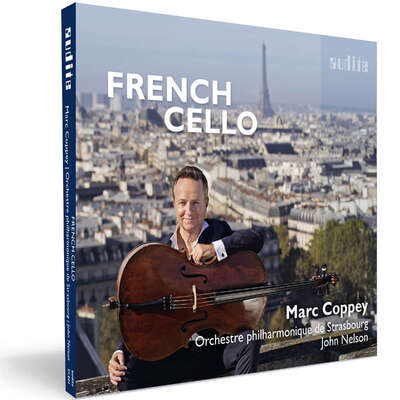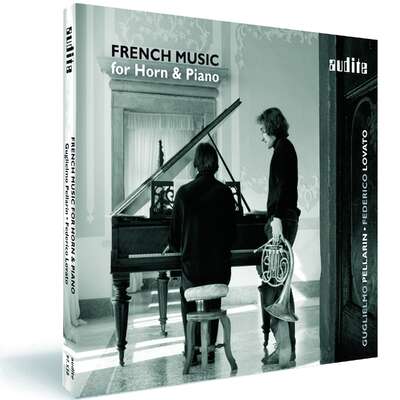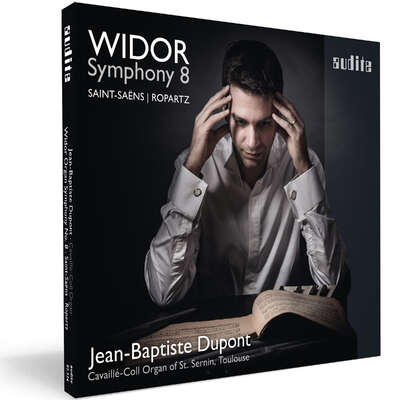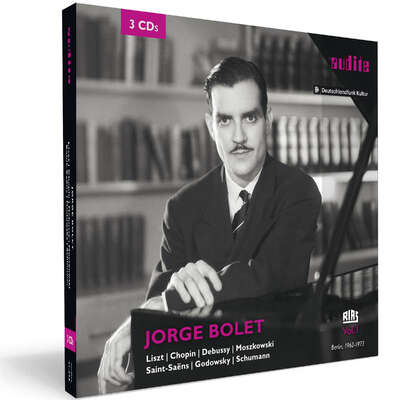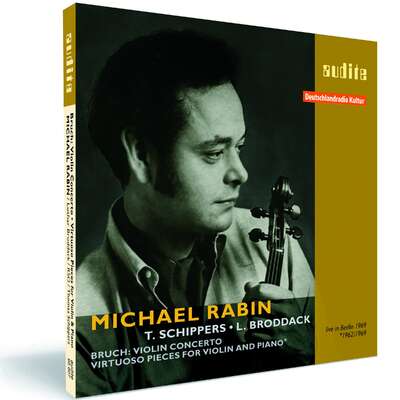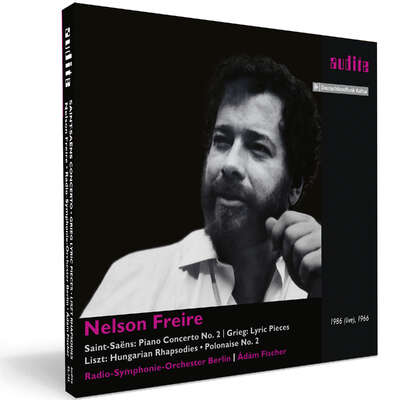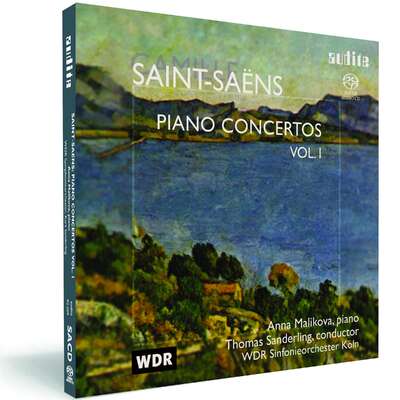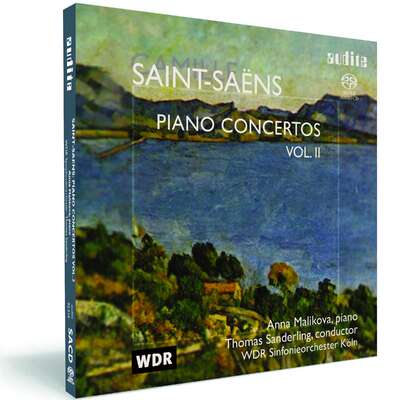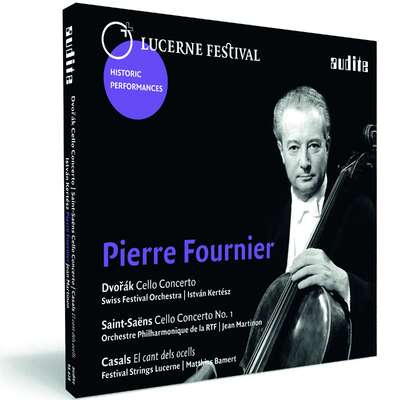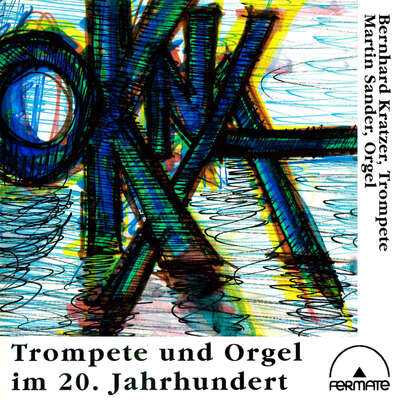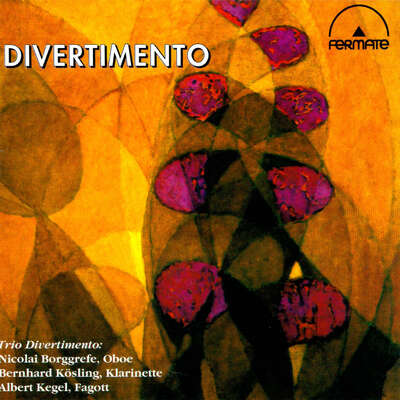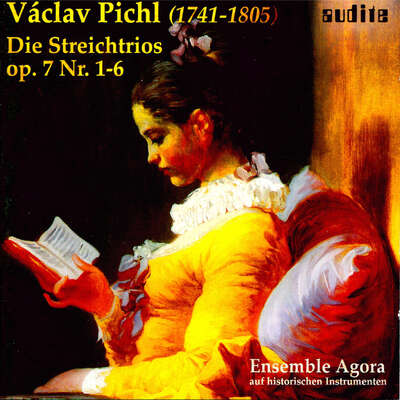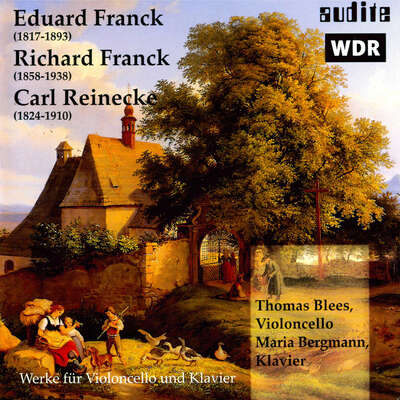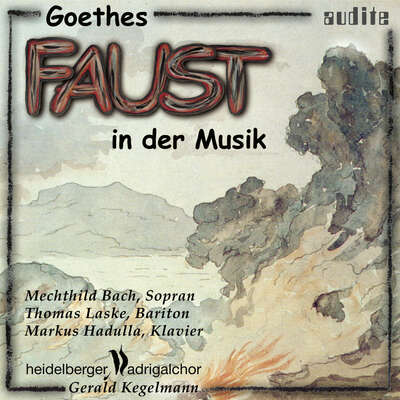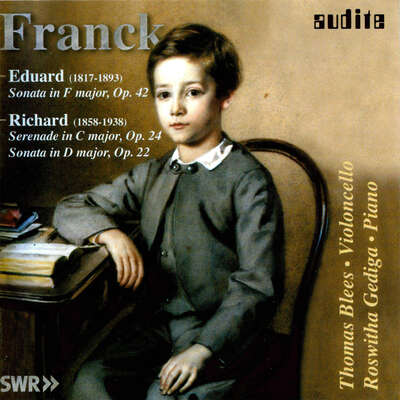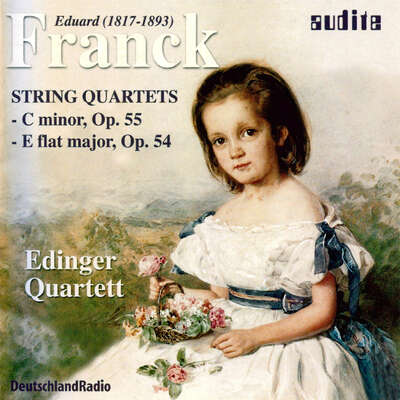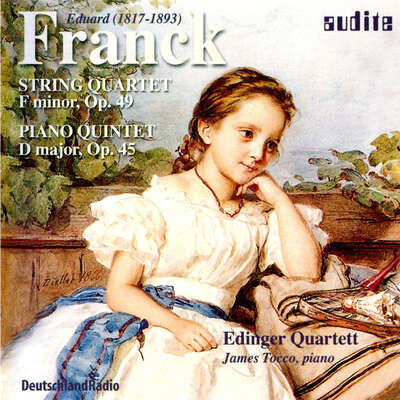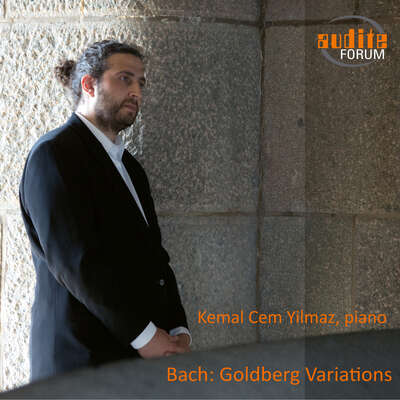
Die beiden Kammermusik-Werke stehen für die frühe Vollendung und für den expressiv-klassizistischen Spätstil von Camille Saint-Saëns. Brillanz und untrüglichen Formsinn, melancholisch-ruhiges Verweilen und energischer Zugriff, romantische Sanglichkeit und erlesene Kompositionskunst – die Kontraste, die Saint-Saëns’ Tonsprache ausmachen, bringt das Quartetto di Cremona musikalisch perfekt zur Geltung.mehr
"Mit feurigem Eifer setzt sich das in Hochform musizierende Quartetto di Cremona für dieses verkannte Meisterwerk ein." (Musik & Theater)
Details
| Camille Saint-Saëns: Piano Quintet & String Quartet No. 1 | |
| Artikelnummer: | 97.728 |
|---|---|
| EAN-Code: | 4022143977281 |
| Preisgruppe: | BCA |
| Veröffentlichungsdatum: | 2. September 2016 |
| Spielzeit: | 63 min. |
Zusatzmaterial
Informationen
Sechs Italiener und ein Franzose: Saint-Saëns' kontrastreiche Tonsprache in Vollendung
Das vielfach preisgekrönte Quartetto di Cremona bringt die ganze Erfahrung einer sechzehnjährigen Konzert- und Aufnahmetätigkeit in seine neueste CD mit Kompositionen von Camille Saint-Saëns ein. Andrea Lucchesini, einer der führenden italienischen Pianisten der Gegenwart, erweitert im Klavierquintett die Quartettformation in der prominenten Rolle des Klavierpartners. Der dritte Satz des Werks wird in der selten dargebotenen Form mit Kontrabass (ad lib.) präsentiert.
Die zwei Kammermusikwerke des französischen Komponisten stehen für wesentliche Phasen seines Schaffens:
Das Klavierquintett, ein Werk der frühen Vollendung, zeigt deutlich die Auseinandersetzung mit der deutschen Romantik, insbesondere mit Robert Schumann und seiner Formensprache. Im ersten Streichquartett, das den Übergang in den Spätstil markiert, verzichtete Saint-Saëns erstmals in der Kammermusik auf sein Instrument, das Klavier. Seine Art des Klassizismus - klar in den Formen, farbig im Ausdrucksspektrum - tritt hier besonders deutlich hervor. Brillanz und untrüglichen Formsinn, melancholisch-ruhiges Verweilen und energischer Zugriff, romantische Sanglichkeit und erlesene Kompositionskunst - die Kontraste, die Saint-Saëns' Tonsprache ausmachen, bringt das Quartetto di Cremona musikalisch perfekt zur Geltung.
Besprechungen
Fanfare | October 2017 | Jerry Dubins | 1. Oktober 2017 | Quelle: http://www.fanfa...
This has been another bumper-crop year of new releases from which I could easily have selected twice the allowed number of entries for my 2017 WantMehr lesen
Here are the also-rans, why I initially considered them, and why I reluctantly ended up eliminating them:
[…] It certainly can’t be said that Saint-Saëns is an obscure or neglected composer, but his chamber works in particular haven’t fared all that well on record. And that is why a new release on Audite by the Quartetto di Cremona playing Saint-Saëns’s Piano Quintet in A Minor and String Quartet in E Minor in exhilarating performances earns a place on my 2017 Want List for some of the best chamber music-making I’ve heard this year.
Musik & Theater | 05/06 Mai/Juni 2017 | Walter Labhart | 1. Mai 2017 Die Entdeckung
Mit feurigem Eifer setzt sich das in Hochform musizierende Quartetto di Cremona für dieses verkannte Meisterwerk ein. Trotz des rekordverdächtigen Tempos im Scherzo herrscht absolute Transparenz, erst recht im fugierten Mittelteil. Mit seinem dominierenden Klavierpart, den Andrea Lucchesini emotional stark auflädt, gleicht das stellenweise orchestral klingende Quintett einem Klavierkonzert mit zahlreichen Streichersoli. Auch da fesseln das fein ausgewogene Zusammenspiel und die klangliche Brillanz.Mehr lesen
Fanfare | March 2017 | Jerry Dubins | 1. März 2017 | Quelle: http://www.fanfa...
It’s quite surprising, really, how few ensembles have taken up these two chamber works by Saint-Saëns. Currently there are fewer than half a dozenMehr lesen
Composed in 1855, the quintet is Saint-Saëns’s first attempt at a chamber work in any form, yet it already displays the composer’s complete confidence in writing for the medium and his recognizable stylistic fingerprints. The aforementioned Presto movement is a wild orage, with hairpin crescendos and diminuendos on single notes, the likes of which are familiar from the second movement of Shostakovich’s Piano Trio in E Minor, which wouldn’t be written for another 89 years. I’ve compared this new performance to the one by the Nash Ensemble on Hyperion which does not include the double bass, and I can report that including it, as the Quartetto di Cremona does here, really makes a difference. It turns the movement from a Category 3 hurricane into at least a Category 4. Batten down the hatches and take cover for this one!
Whatever the reason—perhaps it was awe of Beethoven—Saint-Saëns did not attempt to compose a string quartet until 1899, when he was 64 and already older than Beethoven when the latter died; and Saint-Saëns would only approach the genre once more, in 1918 at the age of 83, three years before his own death. The awe of Beethoven might not be a far-fetched theory, for between 1858 and 1859, Saint-Saëns made a study of Beethoven’s string quartets, transcribing movements from three of them for piano: the Adagio from op. 18/6, the scherzo from op. 59/1, and the finale from op. 59/3. He knew what he was up against.
I’ve had over five years to repent my sin of describing Saint-Saëns’s E-Minor String Quartet as “a tornado in a thimble,” when I reviewed a recording of it by the Fine Arts Quartet in 35:1. I’ve tried in that time to find the work’s redeeming qualities, but my sense of it is that in writing the piece Saint-Saëns was not true to himself and to his innate musical instincts. He took himself and the medium too seriously, as if, somehow, composing a string quartet meant having to assume the mantle of Beethoven. Daniel Morrison took exception to my assessment of Saint-Saens’s quartet in a 37:1 review of the Modigliani Quartet’s recording of the work, referring to an earlier review in 21:6 by Robert McColley who felt the quartet possessed the “subtlety and complexity of musical and spiritual depth … perhaps as close to the masterworks of late Beethoven as anything written since.”
But that’s precisely my point. I keep coming back to Ned Rorem’s apothegm that “everything German is superficially profound; everything French is profoundly superficial.” It may sound simplistic and even politically incorrect, but it contains a kernel of truth, as apothegms usually do. Saint-Saëns was at his best when he was superficial, and I don’t mean that in a disparaging way. The best aspects of his music are in its surfaces, in the intuitive naturalness of its melodies and harmonies that never feel forced or “composed.” We admire the spontaneity and effortlessness of the music’s beauty for its own sake. It doesn’t demand of us that we look for subtlety, complexity, or spiritual depth. In composing his first string quartet, Saint-Saëns seems to have felt the need to seek those things to be worthy of contributing to Beethoven’s great legacy. To my ear, the result is a work that doesn’t really sound like Saint-Saëns, any more than another quartet in the same key sounds like its composer, Verdi. Sometimes I make terse statements in reviews—like Saint-Saëns’s E-Minor String Quartet being “a tornado in a thimble,” without expounding on the reasoning by which I arrived at my conclusion. I hope the foregoing at least explains my thinking, even if you don’t agree with it.
All of that aside, the performances here of both the quartet and the quintet by the Quartetto di Cremona, joined in the latter by Andrea Lucchesini and Andrea Lumachi, are thrilling. The players are on fire, delivering some of the most electrifying and exhilarating chamber music-making I’ve heard. And I will conclude by saying that they make even this listener re-evaluate his opinion of Saint-Saëns’s E-Minor String Quartet, though I still maintain that it sounds more like Beethoven than it does Saint-Saëns. And speaking of Beethoven, I see that in 37:1 and again in 37:5, I could barely contain my enthusiasm for the Quartetto di Cremona’s Volumes 1 and 2 of a new Beethoven quartet cycle. I see from the ensemble’s web site that the cycle is complete on six volumes, but I don’t believe we have received any of them beyond the first two. Someone, please send them posthaste.
Anyway, this Saint-Saëns release is going on my 2017 Want List; it’s that good. Urgently recommended.
www.artalinna.com | 2 February 2017 | Jean-Charles Hoffelé | 2. Februar 2017 | Quelle: http://www.artal... Saint-Saëns Janus
L’excellent Quartetto di Cremona, lancé pour le même éditeur dans une intégrale des Quatuors de Beethoven, brille d’un feu sombre dans le vaste Quintette, mariant son geste à celui si éloquent du pianiste, alors qu’il distille une lumière tout autre au long des prospectives et des inventions brillantes du Premier Quatuor (1899), bien plus couru au disque.Mehr lesen
BBC Music Magazine | February 2017 | Roger Nichols | 1. Februar 2017
Although Saint-Saens is often called a youthful prodigy, as such he wasn't really of the calibre of Mozart or Mendelssohn. His Piano Quintet, writtenMehr lesen
We might therefore hope that Saint-Saens's first chamber work without piano might offer something special. Sadly it doesn't. In 1906 he declared his ambition to write 'a really beautiful string quartet', thereby implicitly criticising his first attempt at the genre, made seven years earlier. It gives me no pleasure to agree. Although the very opening is highly imaginative, from here on duty seems to call, with the weight of tradition sitting heavily on his shoulders. Quite simply, the material is rather dull and predictable, and playfulness is out. Matters are not improved by the close recording, which amplifies the impact of bows on strings with results that can be aurally fairly uncomfortable above mezzo forte; and I'm puzzled by the advertised contribution to the Quintet's scherzo of a double bass, not present in the score nor mentioned in the liner notes…
American Record Guide | January 2017 | Donald R Vroon | 1. Januar 2017
The Piano Quintet has not been recorded often; the same composer’s Piano Quartet has been recorded more. I have three recordings of the quintet, andMehr lesen
The string quartet (No. 1 in E minor) also seems to be a better piece than I had thought—probably again it’s the Italian passion and the German engineering. It still has some boring moments; Saint-Saens often wrote almost automatically.
This is a beautiful recording.
Record Geijutsu | Jan.2017 | 1. Januar 2017
Japanische Rezension siehe PDF!Mehr lesen
Gramophone | December 2016 | Jeremy Nicholas | 1. Dezember 2016
The choice of the first of Saint-Saëns’s two string quartets is a rather apt pairing with the Quintet in that the early Op 14 was written toMehr lesen
This is especially true of the former, which boasts a brilliant piano part (it is easy to imagine the work being arranged as a concerto). The first of the four movements overflows with a superabundance of ideas, the second is a sustained and moving Andante, the third a perpetuum mobile that hurtles along and put me in mind of Alkan’s Le chemin de fer, and the fugal finale is reminiscent of Schumann’s Piano Quintet.
The String Quartet, like the Quintet boasting a lengthy first movement, is less obviously virtuoso, though much of the writing keeps all four players on their toes, not least in the teasing syncopations of the second movement (Molto allegro quasi presto). The exception is the slow third movement, which surely gives the lie to the idea that Saint-Saëns was all glitter and superficial emotion. Here is one of his most deeply felt and intensely personal statements.
The Quartetto di Cremona play with zest, bright colours, great assurance and a tight ensemble that can change direction on a sixpence. Andrea Lucchesini is the excellent pianist in the Quintet and gives Ian Brown a run for his money in the Nash Ensemble’s benchmark recording, but is perhaps a little too forwardly placed in the balance.
Andrea Lumachi (double bass) is billed as playing in the Quintet’s third movement, yet there is no double-bass part in the original score. Or is there? In fact, for some weird reason Saint-Saëns provided an independent part for the instrument with instructions that it remain tacet in movements 1, 2 and 4! There is no explanation for this unique (and, in this case, barely audible) addition anywhere in the booklet-note, which, moreover, misquotes Berlioz and assumes that its readers will have degrees in both musicology and waffle.
Fono Forum | Dezember 2016 | Christoph Vratz | 1. Dezember 2016
Groß ist die Auswahl an Einspielungen des Klavierquintetts von Camille Saint-Saëns nicht. Neuere Aufnahmen stammen von Cristina Ortiz und dem FineMehr lesen
Gerundet wird das halbstündige Werk von den beiden längsten Sätzen: einer "maestoso" gedeuteten Eröffnung und einem langsam sich findenden Finale mit der ungewöhnlichen Bezeichnung "Allegro assai, ma tranquillo". Dessen Beginn erscheint wie eine Erholung nach dem berauschenden Presto. Langsam entwickeln die fünf Solisten diesen Satz, um das erste Thema betont liedhaft und schlicht anzustimmen, bevor der Satz sich mehr und mehr dramatisch auflädt: Lucchesini wuchtet die Akkorde nicht plump in die Tasten, er stimmt sich genau mit den Streichern ab, die kurz darauf das Kommando übernehmen, während sich Lucchesini auf zierlich leuchtende Begleitfigurationen zurückzieht. Eine farbige, erzählfreudige Einspielung. Das zweite Werk auf dieser CD ist das Streichquartett op. 112, geschrieben auf Wunsch von Eugène Ysaÿe. Auch hier bestätigt sich über weite Strecken der positive Eindruck: Die Musiker wollen von Verhüllung nichts wissen und präsentieren Saint-Saëns mit einer sehr unmittelbaren, klaren, abwechslungsreichen Sprache. Dass man geheimnisvoll spielen kann ohne zusätzliche Effekte und Ausrufezeichen, beweist die Aufnahme vor allem im zweiten Satz. Ein Plädoyer für den Kammermusiker Saint-Saëns.
Rondo | 26.11.2016 | Guido Fischer | 26. November 2016 | Quelle: http://www.rondo...
Mit großem Schwung lässt sich dieses subtil aufeinander abgestimmte und reagierende Ensemble auf das Stück ein. [...] Das Opus ist ein Ausbund an bewegender Unruhe und Virtuosität, an zupackender Kraft und Lust am Kontrapunktischen. Und wieder präsentieren sich die vier Streicher des Quartetto di Cremona technisch absolut perfekt und dabei auch irrwitzig temperamentvoll.Mehr lesen
www.pizzicato.lu | 15/11/2016 | Uwe Krusch | 15. November 2016 | Quelle: http://www.pizzi... Italienisches Temperament für den Klassizisten
Camille Saint-Saëns hat die Kammermusik ohne Klavier, also die beiden Streichquartette, erst zu einer Zeit komponiert, in der andere an PensionierungMehr lesen
In beiden Stücken wie auch im Gesamtwerk ist die klassische Ausrichtung erfahrbar. Form, Struktur und Proportionen in den einzelnen Werken sind an den großen Vorbildern orientiert. Anders als viele seiner Landsleute hat Saint-Saëns das Schwergewicht seiner Kompositionen nicht auf die Oper gelegt. Denn auch im Gesamtwerk zeigt sich dieser Klassizismus daran, dass Saint-Saëns alle Gattungen bedacht hat. So gehört ein Viertel seiner Arbeiten zur Kammermusik.
Das ‘Quartetto di Cremona’ hat in erster Linie bei Piero Farulli vom ‘Quartetto Italiano’ und bei Hatto Beyerle vom ‘Alban Berg Quartett’ Ideen gesammelt. Das bedeutet auch, dass es sowohl einen leidenschaftlichen Ansatz mit emotionaler romantischer Komponente als auch den eher klaren und klassischen Stil kennengelernt hat und verbindet sozusagen italienische Spielfreude mit einem deutsch-österreichischen, gepflegten Stil.
Im Pizzicato wurden die Aufnahmen des Quartetts mit den Werken Beethovens in höchsten Tönen gelobt, was man nachvollziehen kann. Bei Saint-Saëns kann diese Einschätzung nicht ganz aufrechterhalten werden. Beim Quintett, also dem Jugendwerk, ist aus dem Werk heraus die eher italienische vitale Spielweise durchaus begründbar. Beim Quartett werden Akzente und Dynamik aber unnötig forciert. Dadurch entsteht ein gewollter Eindruck, der die natürliche Entwicklung eher stört und übertrieben wirkt. Der zweite Satz des Quartetts, Molto allegro quasi presto, wird auch wirklich presto genommen. Aber dadurch wird er auch sehr burschikos und rabiat.
Two chamber works of Camille Saint-Saëns, the Piano quintet and the First String Quartet are vividly performed by the Quartetto di Cremona. The musicians’s Italian temperament is certainly profitable to the Quintet, but pushes a little the more classical character of the Quartet.
www.takt1.de | 01.11.2016 | 1. November 2016 | Quelle: https://www.takt...
[...] das Streichquartett Nr. 1 zeigt eine tiefe Innerlichkeit, bricht aber immer wieder emotional aus: Kongenial komponiert und interpretiert: Strukturell klar und elegant, nicht überbauschend expressiv.Mehr lesen
CD Journal | 49.11 | 1. November 2016
Japanische Rezension siehe PDF!Mehr lesen
Sunday Times | 23.10.2016 | SP | 23. Oktober 2016
Lucchesini plays with brilliant deftness, while the Cremona Quartet demonstrate their trademark combination of Italianate flair and immaculate ensemble.Mehr lesen
WDR 3 | WDR 3 TonArt | 20.10.2016 | Birgit Nockenberg | 20. Oktober 2016 | Quelle: http://www1.wdr....
BROADCAST
Im Porträt: Das Quartetto di Cremona
Es gibt heute nur noch wenige renommierte italienische Streichquartett. Das Quartetto di Cremona ist seit 16 Jahren eines davon. Das Quartett wirdMehr lesen
Sendebeleg siehe PDF!
Radio Bremen | 15.10.2016, 18.05 Uhr Magazin Klassikwelt | Marita Emigholz | 15. Oktober 2016 | Quelle: http://sport.rad... BROADCAST Magazin Klassikwelt
Sendebeleg siehe PDF!Mehr lesen
Hessischer Rundfunk | hr2 CD-Tipp am 3.10.16 | 3. Oktober 2016 CD-Tipp
leider kein Sendebeleg verfügbar!Mehr lesen
www.myclassicalnotes.com | September 28, 2016 | 28. September 2016 | Quelle: http://www.mycla...
I was hardly familiar with the chamber music by Camille Saint-Saens until I came across this new recording. [...] the music is beautifully presented by the Quartetto di Cremona.Mehr lesen
Kulturspiegel | 09/2016 | Dr. Johannes Saltzwedel | 1. September 2016
Edle Spätromantik mit dem Quartetto di Cremona und Andrea Lucchesini am Klavier.Mehr lesen
Der neue Merker | 29.08.2016 | Dr. Ingobert Waltenberger | 29. August 2016 | Quelle: http://der-neue-... Das schönste französische Klavierquintett und Streichquartett von sechs famosen Italienern glorios interpretiert – Vive l‘Italie!
Bei Audite ist ein kompletter Streichquartettzyklus von Beethoven im Entstehen, und schon jetzt kann gesagt werden, dass er neue Maßstäbe setzt und in seiner strukturellen Klarheit, aristokratischen Eleganz, gediegenen Sanglichkeit und klanglichen Rafinesse schwer zu überbieten sein wird. Mehr lesen
Neuigkeiten
This has been another bumper-crop year of new releases from which I could easily...
It’s quite surprising, really, how few ensembles have taken up these two...
The Piano Quintet has not been recorded often; the same composer’s Piano...
Although Saint-Saens is often called a youthful prodigy, as such he wasn't...
The choice of the first of Saint-Saëns’s two string quartets is a rather apt...
Wenn man es nicht besser wüsste, könnte man glatt vermuten, dass Camille...
Dass es sich unbedingt lohnt, Camille Saint-Saëns abseits vom Karneval der...
Groß ist die Auswahl an Einspielungen des Klavierquintetts von Camille...
Anyone who thinks Saint-Saëns to be a composer of the merely light or...
I was hardly familiar with the chamber music by Camille Saint-Saens until I came...
Edle Spätromantik mit dem Quartetto di Cremona und Andrea Lucchesini am...
Das schönste französische Klavierquintett und Streichquartett von sechs famosen Italienern glorios interpretiert – Vive l‘Italie!






























